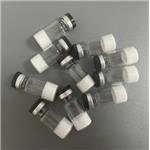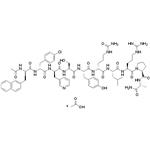Description
Cetrorelix is a synthetic peptide antagonist of the gonadotropin-releasing hormone receptor (GnRHR) with a K
d value of 0.2 nM for radioligand binding to murine LTK- cells expressing human GnRHR. It inhibits the activation of hGnRHR and a downstream luciferase reporter gene in murine LTK- cells by the GnRHR agonist [D-Trp
6]GnRH (IC
50 = 1.2 nM).
In vivo, cetrorelix (60 μg per day) reduces tumor volume to 35% of control and decreases serum luteinizing hormone levels by 50% in a human epithelial ovarian cancer mouse xenograft model. Centrorelix (0.5 mg/kg) protects the primordial follicles (PMF) in mouse ovaries from damage induced by cyclophosphamide with 65% to 86% PMF survival compared to 46% PMF survival with a saline control. Formulations containing cetrorelix have been used to prevent ovulation during
in vitro fertilization.
Uses
Cetrorelix, a luteinizing hormone releasing hormone receptor (LHRHR) antagonist, was used to study its safety, mechanism of action, metabolism, and efficacy as a therapeutic agent for the treatment of blood cancers such as multiple myeloma (MM). Cetrorelix is used to evaluate its effects on a wide range of physiological processes and malignancies that involve luteinizing hormone releasing hormone receptor signaling pathways involving processes such as steroidogenesis.
Uses
Cetrorelix Acetate is an gonadotropin-releasing hormone antagonist and is used to treat hormone-sensitive cancers of the prostate and breast.
Definition
ChEBI: The acetic acid salt of cetrorelix. A gonadotrophin-releasing hormone (GnRH) antagonist, it is used for treatment of infertility and of hormone-sensitive cancers of the prostate and breast.
Biochem/physiol Actions
Cetrorelix acetate is a luteinizing hormone releasing hormone receptor antagonist. It causes prepubertal reduction in bone modeling, bone density and bone strength comparable to post-menopausal bone loss.




